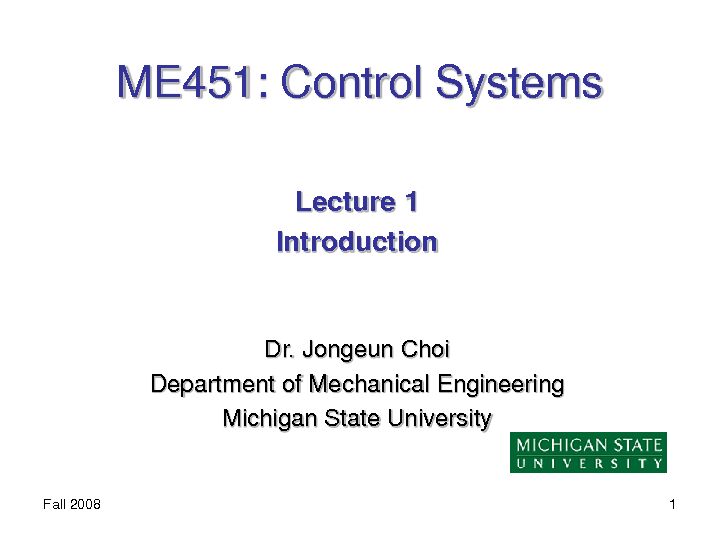Control theory is a relatively new field in engineering when compared with core topics, such as statics, dynamics, thermodynamics, etc Early examples of control systems were developed actually before the science was fully understood For example the fly?ball governor developed by James Watt to control
Convenient (room temperature control, laundry machine) Dangerous (hot/cold places, space, bomb removal) Impossible for human (nanometer scale precision positioning, work inside the small space that human cannot enter) It exists in nature (human body temperature control) Lower cost, high efficiency, etc Many examples of control systems around us
The modern trend in engineering control systems is toward greater complexity due to the requirements of complex tasks and good accuracy Modern complex systems may have many inputs and many outputs linear or nonlinear systems, to analyze such systems it is essential to reduce the complexity of the mathematical expressions

64677_3ME451_L1_Introduction.pdf
Fall 20081
ME451: Control Systems
Dr. Jongeun Choi
Department of Mechanical Engineering
Michigan State University
Lecture 1
Introduction
Fall 20082
Instructor
Class Instructor:Dr. Jongeun Choi,
Website:
http://www.egr.msu.edu/~jchoi/
Associate Professor at ME department,
2459 Engineering Building,
Email: jchoi@egr.msu.edu
Office Hours
2459 EB, MW10:00-11:00am, Extra hours by
appointment
Laboratory Instructor:Dr. Jongeun Choi
3
Course information
Lecture:
When: MWF: 11:30am-12:20pm
Where:
008 Urban Plan & Land Arch
Bldg
Class and Laboratory website:
http://www.egr.msu.edu/classes/me451/jchoi/2014/ http://www.egr.msu.edu/classes/me451/me451_labs/Fall_201
4/index.html
Required Textbook:
Modern Control Systems, Richard C. Dorfand Robert H. Bishop, Prentice Hall, 12th edition, 2010, ISBN-10: 0-13-
602458-0
Fall 20084
Main components of the course
Lectures (about 40 lectures)
Midterm1 (October 3rd, Friday, in class)
Midterm2
Final (Final exam period)
Laboratory work
Grading:
Homework (15%), Exam 1 (15%), Exam 2 (15%),
Final Exam (comprehensive) (30%), Laboratory work (25%) Homework will be due in one week from the day it is assigned
Fall 20085
Tips to pass this course
Come to the lectures as many times as you can.
Print out and bring lecture slides to the lecture.
Read the textbook and the slides.
Fall 20086
Make some object (called
system, or plant ) behave as we desire.
Room temperature control
Car/bicycle driving
Voice volume control
Cruise control or speed control
Process control
etc.
Fall 20087
Why do we need control systems?
Convenient (room temperature control, laundry
machine)
Dangerous (hot/cold places, space, bomb removal)
Impossible for human (nanometer scale precision
positioning, work inside the small space that human cannot enter) It exists in nature. (human body temperature control)
Lower cost, high efficiency, etc.
Many examples of control systems around us
Fall 20088
Open -
Loop Control
Open - loop Control System
Toaster, microwave oven, shooting a basketball
Calibration is the key!
Can be sensitive to disturbances
PlantController
(Actuator)
Signal Inputinputoutput
Fall 20089
Example: Toaster
A toaster toasts bread, by setting timer.
Objective:
make bread golden browned and crisp.
A toaster does
not measure the color of bread during the toasting process. For a fixed setting, in winter, the toast can be white and in summer, the toast can be black (Calibration!)
A toaster would be more expensive with
sensors to measure the color and actuators to adjust the timer based on the measured color.
Toaster
Setting of timer
Toasted bread
Fall 200810
Example: Laundry machine
A laundry machine washes clothes, by setting a
program.
A laundry machine does
not measure how clean the clothes become.
Control without measuring devices (sensors) are
called open - loop control .
Machine
Program setting
Washed clothes
Fall 200811
Closed
-
Loop (Feedback) Control
Compare actual behavior with desired behavior
Make corrections based on the error
The sensor and the actuator are key elements of a feedback loop
Design
control algorithm Plant
Sensor
Signal InputErroroutput
+-
ActuatorController
Fall 200812
Attempts to change the direction of the automobile.
Manual closed
- loop ( feedback ) control. input and the output of the system can be different, depending on control objectives !
Ex: Automobile direction control
Auto
Steering
wheel angle
Direction
Desired
direction Eye Hand Brain Error
Fall 200813
Attempts to maintain the speed of the automobile.
Cruise control can be both manual and automatic.
Note the similarity of the diagram above to the
diagram in the previous slide!
Ex: Automobile cruise control
Auto
Acceleration
Speed
Desired
speed
Sensor
Actuator
Controller
Disturbance
Error
Fall 200814
Basic elements in feedback control
systems Plant Input
Output
Reference
Sensor
Actuator
Controller
Disturbance
Control system design objective
To design a controller s.t. the output follows
even in the face of disturbances. Error
Fall 200815
Systematic controller design process
Plant Input
Output
Reference
Sensor
Actuator
Controller
Disturbance
1. Modeling
Mathematical model
2. Analysis
Controller
3. Design
4. Implemenation
Fall 200816
Goals of this course
To learn basics of feedback control systems
Modeling
as a transfer function and a block diagram
Laplace transform (Mathematics!)
Mechanical, electrical, electromechanical systems
Analysis
Step response, frequency response
Stability: Routh
-
Hurwitz criterion, (Nyquist criterion)
Design
Root locus technique, frequency response technique,
PID control, lead/lag compensator
Theory, (simulation with Matlab), practice in laboratories
Fall 200817
Course roadmap
Laplace transform
Transfer function
Models for systems
mechanical electrical electromechanical
Linearization
Modeling
Analysis
Design
Time response
Transient
Steady state
Frequency response
Bode plot
Stability
Routh -
Hurwitz
(Nyquist)
Design specs
Root locus
Frequency domain
PID & Lead
- lag
Design examples
(Matlab simulations &) laboratories
Fall 200818
Summary & Exercises
Introduction
Examples of control systems
Open loop and closed loop (
feedback ) control
Automatic control is a lot of fun!
Next
Laplace transform
Exercises
Buy the course textbook at the Bookstore.
Read Chapter 1 and Apendix A, B of the textbook.
 64677_3ME451_L1_Introduction.pdf
64677_3ME451_L1_Introduction.pdf